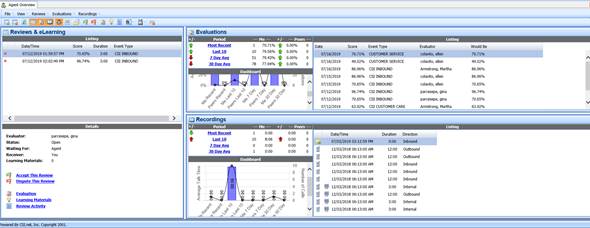By
Ellen Colavito
|
Date Published: July 16, 2019 - Last Updated December 03, 2019
|
Comments
We’ve all seen it happen in contact centers. New key performance indicators (KPIs) kick-off with conviction but eventually fade into the background as agents’ focus returns to the immediate task of serving customers. Though they’re introduced with good intentions, the metrics often don’t last.
Workforce optimization (WFO) portals for agents are changing that.

The portals are like individual dashboards that plot real-time KPIs for each agent, such as average handle time, the number of calls taken, schedule adherence, quality evaluations, and Voice of the Customer (VOC) analytics. By giving agents direct feedback, the portals produce several benefits:
Engage agents, align them with the organization’s initiatives
WFO portals allow agents to become actively involved in their performance. Instead of relying on their supervisor for feedback, the portals empower agents to succeed. Customizable dashboards and robust KPI reports give agents a clear understanding of their strengths and weaknesses. The portals also promote a healthy competitive environment by providing agents with anonymous reporting and productivity results relative to their peers. Some applications even use gamification techniques, like badges and ribbons, to encourage participation. WFO portals deliver a clear and consistent message, so everyone is aligned.
Provide timely communication between the agent and leadership
WFO portals keep agents on task. They receive timely feedback regarding opportunities to improve performance. Timing is critical in a high-volume contact center. WFO portals allow agents to address performance issues while still maintaining optimal productivity. Agents have a voice, which keeps them actively involved and engaged in the quality process. Should they feel there are inaccuracies with scoring, there is a dispute process that reinforces open and continuous communication with their supervisor. Agents appreciate the collaborative approach, which motivates and encourages them to be productive at a high level.
Tailor and Improve Training
Continuous learning is always a priority in call centers. Leadership can attach pertinent learning materials to agent evaluations and upload them to portals for their review. Combining drill-down reporting with eLearning, leadership can identify performance gaps at the organizational level and at the agent level. As a result, they can quickly address performance concerns impacting the customer experience.
Meet Specific Business Needs
Portals can be fully loaded with features that allow agents to listen to calls, view evaluations, participate in eLearning, view performance-related reporting, and more. Or, they can be customized to support a level of engagement determined by leadership. Often, internal processes and policies determine the amount of information to be displayed. As companies evolve, portal functionality can be updated at a keystroke.
Enable productive and effective coaching sessions
From a leadership perspective, WFO portals keep the agents “looped in,” at times when face-to-face coaching sessions aren’t possible. The portals don’t replace one-on-one sessions they enhance them. Agents attend coaching sessions prepared, and leadership has everything at their fingertips to provide an effective and collaborative coaching session. The agent feels valued, supported, and encouraged, which ultimately translates into a positive customer experience.
When contact center agents can access performance criteria, they take ownership of their success. WFO portals also help to ensure data is captured correctly and processes are followed. Not only do agents see that management uses the data, but they can also use the data, themselves. Companies don’t get this level of buy-in with closed-door, top-down mandates.
The result is that when individual agents improve their performance, the entire contact center improves performance.
(photo © selinofoto - stock.adobe.com)